Ethnographic Park in Tokarnia
Manor - Farm Sector
MANOR HOUSE FROM SUCHEDNIÓW
The manor house from Suchedniów was built at the beginning of the 19th century on a horseshoe plan. It was the property of Wincenty Tarczyński. Until the end of the 19th century, a post station operated in the building.
The outer walls were made of larch boarded balks and the partitions were made of fir wood. The manor was covered with a half-hipped roof, covered with a double layer of fir shingle. In front of the main entrance there is a column porch with a gable roof. The windows are equipped with external shutters, mounted on the hinges of the blacksmith's work.
The interior was arranged in a way typical of the standard of living of a middle-class noble family from the second half of the 19th century. The living room is the most representative room of the manor, here official guests were received. Here you can find two sets of furniture in the style of Ludwik Filip as well as a classicistic chest of drawers, a cabinet with dishes with a decorative function and a wall hanging from Buczacz.
Behind the living room is the householder's bedroom. In the bedroom, the basic toilet actions took place, a wardrobe and a needlework table could be find there as well. The bedroom has two double beds, a chest of drawers in the style of Louis Philippe, an eclectic wardrobe and a black polished women's desk in the style of Napoleon III. The equipment is complemented by night utensils and a decorative turtle-shaped spittoon.
The manor also had a parlour (a room for small family gatherings) - manor etiquette did not allow hosting less trusted guests here. In the living room, the closest family members and their friends spent the evenings enjoying "home concerts" or reading. The walls of this room are decorated with drawings showing the historical buildings of Poland. In the living room there is a piano from the famous Warsaw workshop of Józef Walenty Budynowicz, a cabinet with dishes, a table with chairs and a beautiful Art Nouveau pier glass. An indispensable room of the manor was the study (the place of work and rest of the house master and the property manager). Traditionally, it contained a "panoplium" - a decorative exhibition of cold steel, placed on the background of the rug. The room is also furnished with an empire-style couch and a davenport with a collection of farm books, textbooks, atlases and fiction.
In the dining room, the whole family gathered for meals, which were announced by a bell placed at the main entrance to the house. Centrally, the dining room is occupied by a large table with a set of high-backed chairs and cane-woven seats. There is a clock in the corner and a samovar under the window, opposite is a sideboard for tableware, family portraits are hung on the walls.
Old furniture and a number of utility equipment were stored in the utility hall. The room also used as a bathroom. In the hall there is also a large copper tub and a second stave tub and sideboard, its walls are decorated with hunting trophies.
The place to prepare daily meals, as well as prepare food stores, stored in the pantry (located next door) was the kitchen. There is a large brick kitchen stove with a cast iron plate and stove lids, and a bread oven, clay-stained and whitewashed. In the kitchen there is a sideboard, shelf, table, water pot, chopping block. You can see a a lot of kitchen appliances here: knives, spoons, cleavers, various forms and molds, bottles and dishes. On the kitchen plate there is a coffee roasting device, and at the entrance to the pantry - a wooden churn.
Behind the arcade passage in the base of the chimney there is a servant chamber in which the service performed their work: ironing, spinning, sewing, washing and minor equipment repairs. In this room, inferior furniture was placed: a wardrobe, a massive table, a dresser, a sideboard and a hand mangle. At the table you can see the spinning wheel and there are various types of irons on the dresser.
Next to this room there is a resident's room - an impoverished relative who, in exchange for hospitality, helped the farm. The room is equipped with basic furniture: a bed, a dresser, a cupboard, a table with chairs and a sink. The decor of this room is complemented by women's trinkets and religious items.
GRANARY FROM ROGÓW
The court granary from Rogów was built in 1684, what is certified by the date cut on two original copper flags crowning the ridge. On one of them the crest of former, great owners - Firlejów and Wodzicki is painted. The object is one of the most valuable monuments of this type in Poland. Originally it was placed just on the Wisła River bank, it was part of the group of Rogów granaries used for storing grain, floated to Gdańsk. Around 1870, the owners of the property moved the building to the edge of the village, near the famous, no longer existing, 17th century court from Rogów. Then the granary, formerly entirely wooden, obtained the foundation and the ground floor made of red brick. The walls of the building were made of fir wood, additionally reinforcing them with a half-timbered structure. The walls of the third floor (attic) are in post-and-plank construction. The half-timbered construction is drawn by the powerful corner poles with a cross-section of 50x50 cm - each made of only one piece of larch wood. Among the preserved original architectural details, large and thick oak doors on the first and second floors, hung on forged belt hinges, deserve attention. The whole building is covered by a double-shingle roof structure. Granary window openings have a semi-circular pattern and are protected with iron, forged grilles. Periodically, they were obscured by wooden shutters with semicircullar finished top. The last owners of the granary from Rogów was the Skórzewski family, whose property was taken over by the state after 1945. The building was bought by the Provincial Conservator of Monuments in 1972.
GRANARY FROM ZŁOTA
The granary in Rogów upon Wisła was built in 1719, its founder was Eliasz Wodzicki. Then, probably before 1850, it was disassemled and moved to the town of Złota. This impressive outbuilding was built of larch, pine and oak wood, in a log construction, on a rectangular plan with dimensions of 26.25 x 9.75 meters. Above the main entrance you can read the original foundation inscription with the letters "MM" - the builder's initials. The Granary was a two-story building, without basements, with a huge attic. On the first and second floors, there were two chambers separated by a centrally located hall. Particularly noteworthy here is the beautiful roof of Cracow type, covered with shingles, as well as profiled tenons of overhead beams - the so-called "Lynx". The bevelling of the edges in the poles and columns supporting the girders inside the building is also decorative. Due to its age, shape and construction details, the building is one of the most valuable farm buildings from the Baroque era in Poland. On the first floor of the granary from Złota, permanent exhibitions dedicated to traditional blacksmithing and folk costumes of the Kielce region are presented. In the granary's chambers, on the ground floor, exhibitions, educational activities, scientific sessions and occasional events are organized, including tasting of regional dishes.
MANOR BARN FROM RADKOWICE
The building comes from the manor estate of Wanda Pomianowska, it was built in 1855. This impressive structure measuring 30x12 meters was erected in a post-and-plank structure of hewn beams. It consists of two silos and a double drive bay, two gates located in both longer walls of the barn lead to it. It has a hipped roof covered with thatch. Inside the barn, an exhibition was organized entitled: "Manor Stable. Vehicles from the Jan Wzorek collection. " You can see peasant carts, carriages, "Krakow carts", wagons, sleighs and carriages. Among the collections is the valuable and rare "balagułka", produced in an unknown workshop around 1900. "Balagulkan style" was characteristic for the areas beyond the Bug River and in Wołyń and Podole. Other interesting vehicles are: a bakery cart from Kielce, used for transporting and selling bread, a fire truck and a horse-drawn mail cart, which transported shipments between Kielce and Busko-Zdrój until the 1950s. In the manor barn of Radkowice you can also admire, among others a court "ruler" from the Łomno estate in the Świętokrzyskie Mountains, which served for field detour and recreation, as well as a delicate "doctor", thanks to which the city doctor could visit the sick.
GRANARY FROM STASZOW
The exact date of construction of this granary is unknown. It is known that it was built in the second half of the 18th century. This building is the only example in the Kielce region of a narrow-front granary built on a square plan. In the second half of the 19th century, the building belonged to the Malewski family. A two-storey granary, has larch walls wedged "overlay" (one and two-sided) with decorative, profiled, long so-called "rysie (Lynx)" left at the top. On the ground floor there are sight glasses. Doors are hung on belt hinges. Floors are made of planed boards 4 cm thick and 25-30 cm wide. The granary is covered with a half-hipped, high roof, covered with shingles, with a pair of windows cut out at the top. The original look of the granary is additionally emphasized by a wooden "attic room" illuminating the highest attic. The building was disassembled and moved to an museum in 1981.
OŚMIORAK FROM RUDA PILCZYCKA
"Ośmiorak" z Ruda Pilczycka was built around 1914. It is an interesting example of a multi-family wooden farm house from the 19th century (its variety is known from the literature "czworaki" - living quarter in a farm) intended for manor service. The founder of the building was Władysław Zamojski, a landowner, the last owner of the Pilczyce estate. "Ośmiorak" is a wooden building, set on a stone foundation, erected on a rectangular plan with dimensions of 32.20x11.54 m. It is a single-storey, wide-front building, covered with a gable roof, covered with shingles. It consists of eight "apartments" in the layout of the hall - chamber - room. A brick bread oven was recreated in one of the rooms. The other rooms currently serve as guest rooms and are comfortably furnished.
WINDMILL FROM GRZMUCIN
A wooden windmill from Grzmucin ("paltrak" type) was built in 1921 in place of an older, destroyed "koźlak" type windmill. The building was made to order of the miller Józef Jaszewski from Grzmucin. It was erected by a carpenter and mill builder, Paluszkiewicz who built at least two similar "paltraks" in the area. In the windmill from Grzmucin, grain was milled until 1950. "Paltrak" was turned to the wind direction by means of a winch with a rope, called "baba". The windmill was placed on a low, central pile and on six steel trolleys with rollers moving along a steel rail in the shape of a circle. The rail was attached to a wooden ring, laid on a stone foundation. The trolleys are supported by a massive "cross-brace" made of oak beams, in which the supporting columns are embedded, which are part of the building's skeleton construction, complemented with transoms and horizontal beams of three floors of the windmill. The paltrak mechanism consists of two wings ("sails"), a wing shaft with a top wheel (visible on the third floor) and a vertical shaft with a crown wheel, passing through all the floors of the windmill. An auxiliary device (visible on the third floor) enabling stopping the operation of the mill is a brake called the "stawidło". After braking the arms it was possible to fine-tune the speed of rotation of the wings. On the second floor of the windmill, two milling stones were installed (in this case called "French"). In the lower storey you can see flour sifter and a channel with a bucket mechanism cover, thanks to which the "grist" was transported upwards for repeated milling.


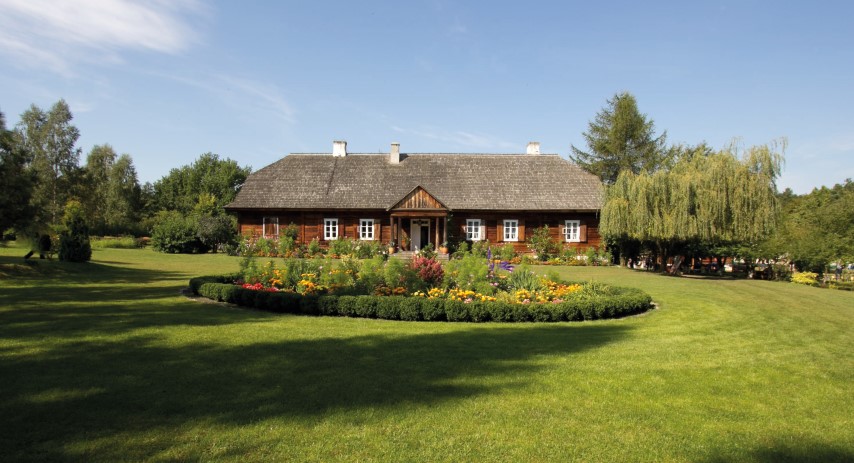
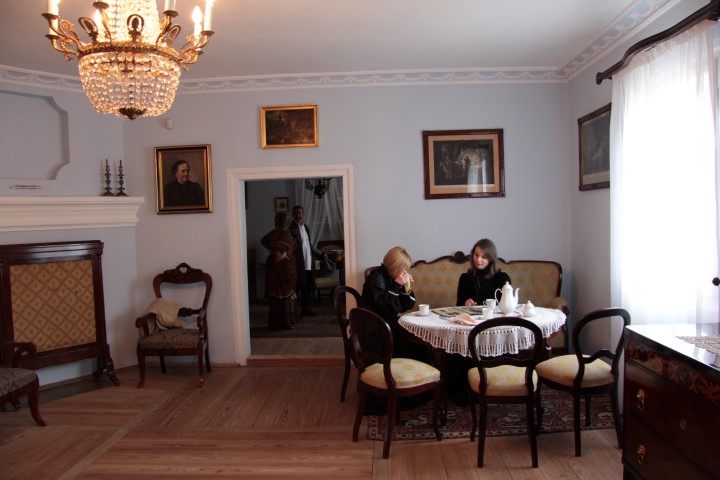
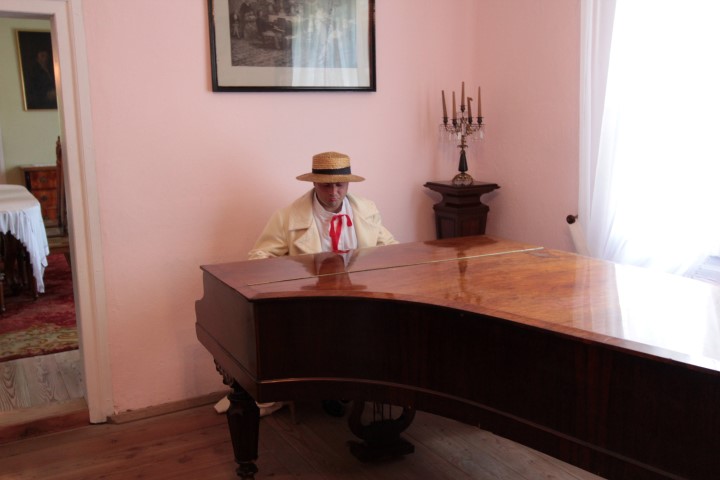
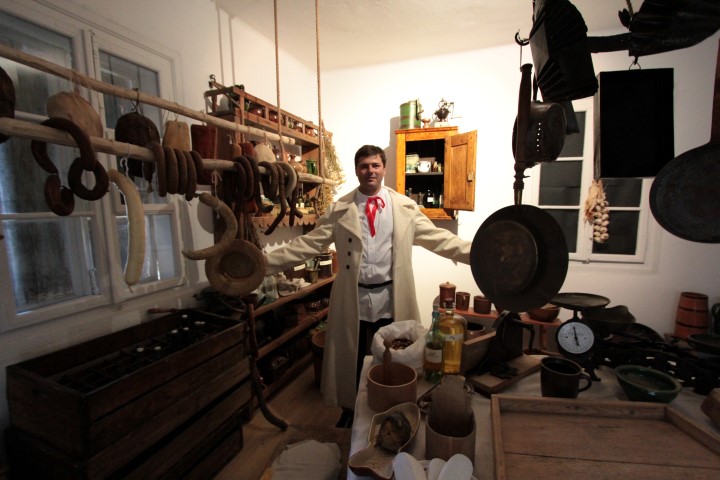
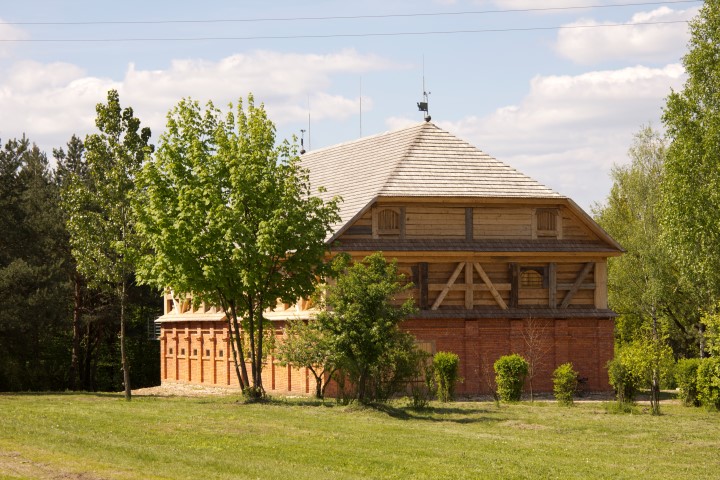
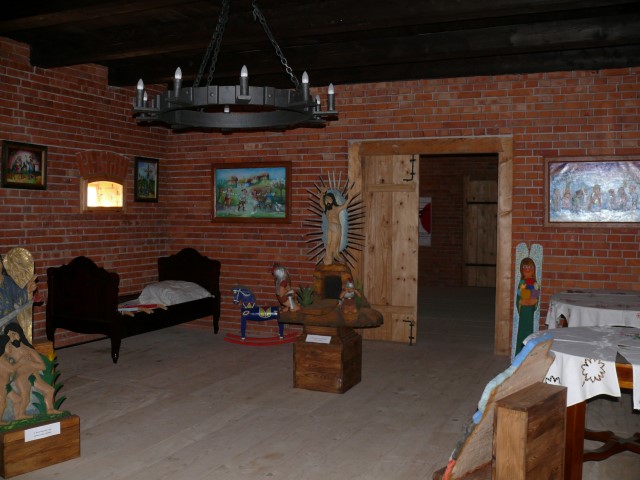
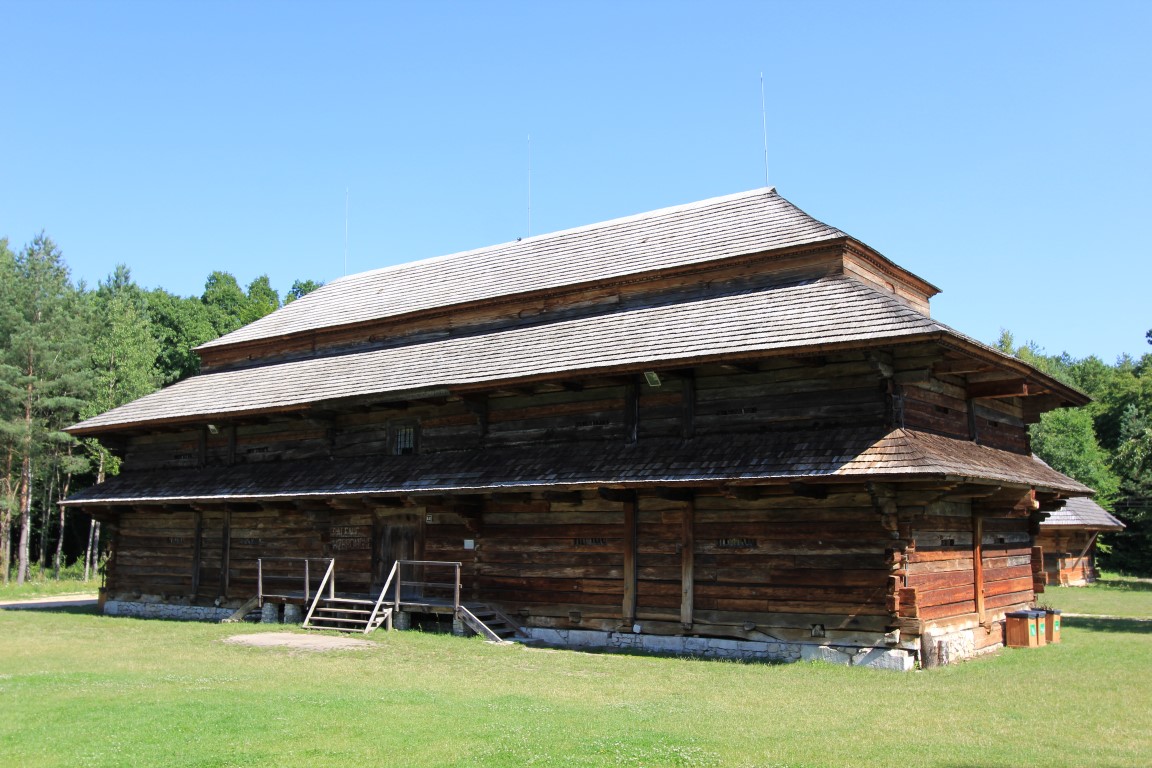
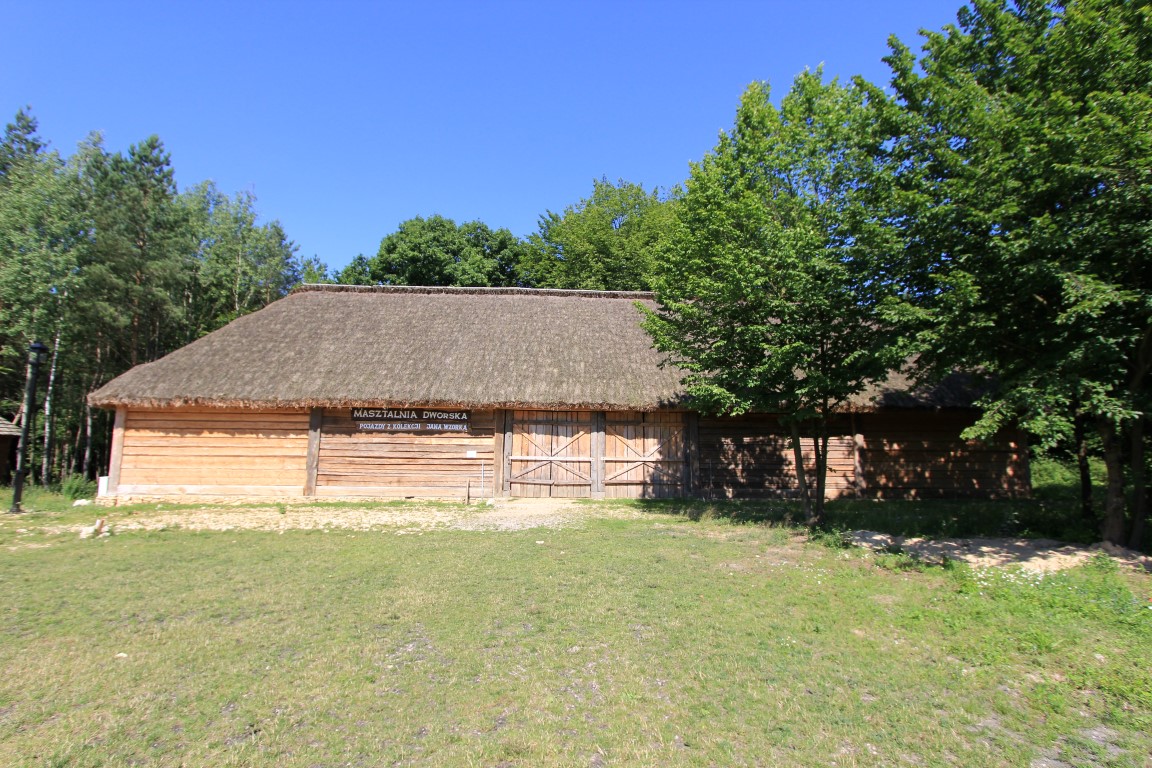
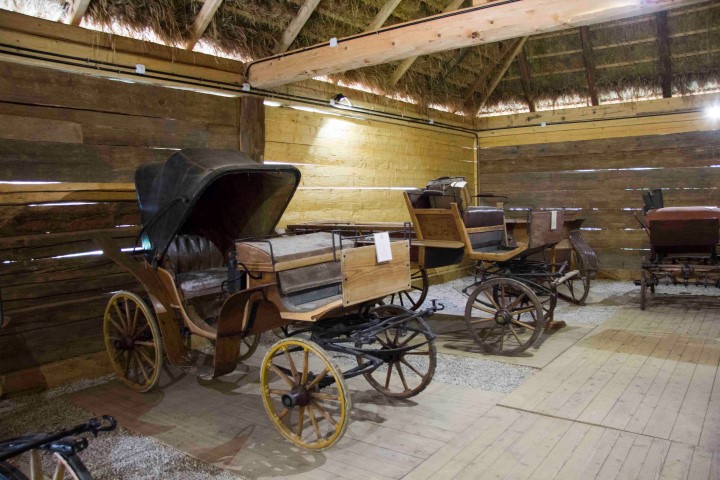
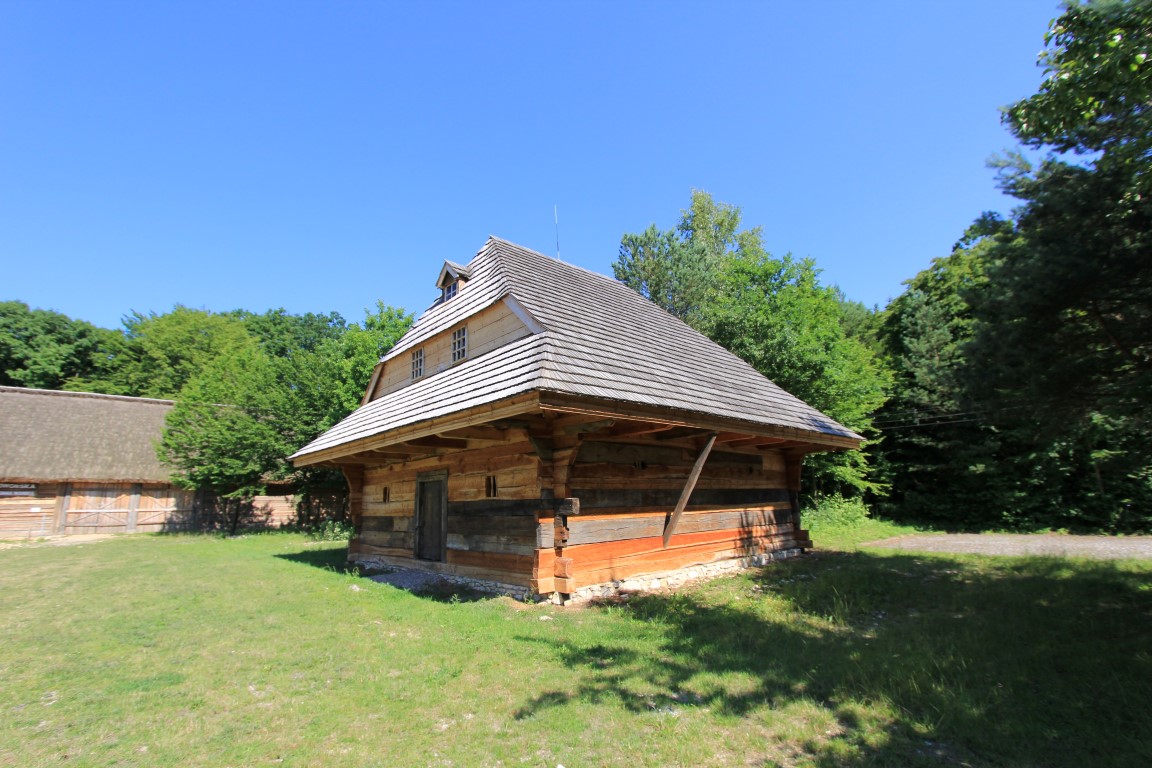
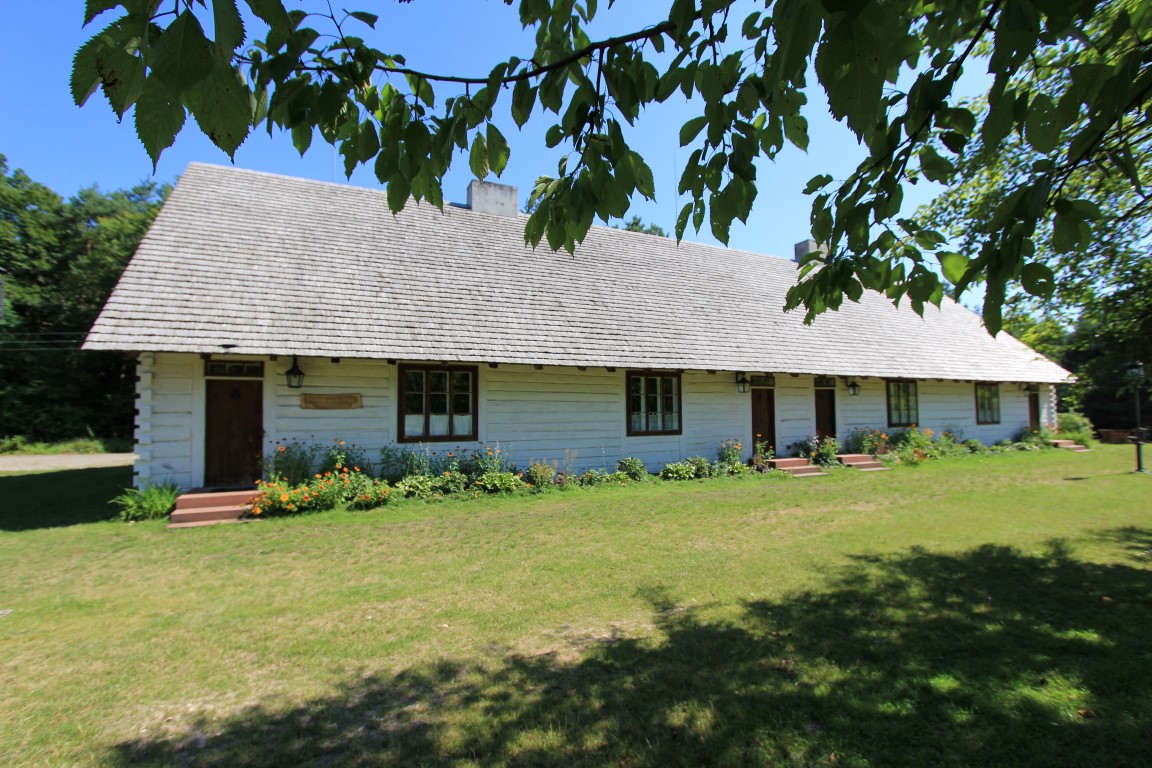
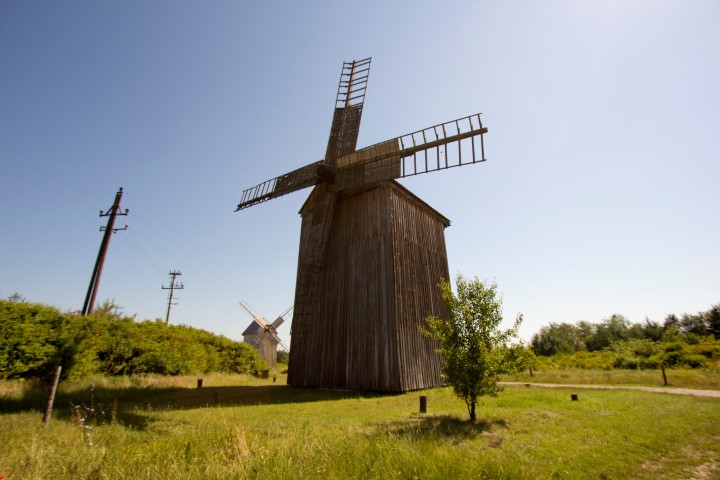

 Zakup współfinansowany ze środków Unii Europejskiej w ramach Europejskiego Funduszu Rozwoju Regionalnego na lata 2014 – 2020
Zakup współfinansowany ze środków Unii Europejskiej w ramach Europejskiego Funduszu Rozwoju Regionalnego na lata 2014 – 2020